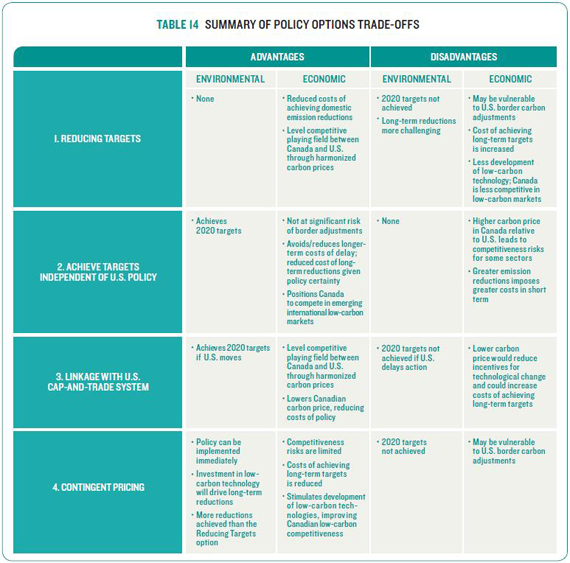Parallel Paths – 5.2 Summary of Policy Options
How then, can Canada reduce competitiveness impacts from higher carbon prices in Canada relative to the U.S. while still achieving emission reductions and protecting itself against border carbon adjustments?
Different policy approaches to achieve this goal are possible, but all approaches have trade-offs:
- CANADA COULD REDUCE ITS 2020 GHG TARGET. Reducing our targets below those of the U.S. would result in lower carbon prices than now anticipated and lead to carbon prices comparable to those of the U.S. This approach would level the competitiveness playing field, but would result in fewer emission reductions. To achieve harmonized carbon prices, NRTEE analysis suggests Canada would have to reduce its target to 8 % below 2005 levels by 2020, rather than the current target of 17 %.
- CANADA COULD ACHIEVE ITS 2020 TARGET, INDEPENDENT OF U.S. POLICY CHOICES. While this approach would allow Canada to achieve its 2020 targets no matter what, it would impose a higher carbon price in Canada relative to the United States, particularly in the short term. Canadian trade-exposed and emissions-intensive sectors would be vulnerable to competitiveness risks. Free permit allocations to trade-exposed and emissions-intensive sectors through a national cap-and-trade system could reduce the total costs of the policy for such sectors and firms within them.
- CANADA COULD LINK WITH A U.S. CAP-AND-TRADE SYSTEM. Linking carbon trading systems would result in a convergence of carbon prices and so create an equal playing field for Canadian and U.S. firms. But two main problems could make linkage problematic for Canada in the short term. First, U.S. action on establishing a cap-and-trade system does not appear imminent and could lead to delays in implementing Canadian climate policy. Second, a linked trading system would result in a higher carbon price in the U.S. than an American-alone system, making linkage potentially less appealing to policy makers there.
- CANADA COULD APPLY A CONTINGENT PRICING APPROACH. This approach would reduce and limit the carbon price differential between Canada and the U.S. and make up the emissions reduction gap through a combination of international purchases, domestic offsets, and a technology fund. Limiting the carbon price differential between Canada and the U.S. would put Canadian policy somewhere between harmonizing on price and harmonizing on targets. It would limit competiveness impacts by not allowing the Canadian price to be too far out of alignment with the U.S. price. Yet a somewhat higher Canadian carbon price at this time would drive more domestic abatement than a pure price harmonization approach, and provide a stronger incentive for innovation and long-term reductions through greater policy certainty to Canada’s industrial, business, and financial sectors.
Le Tableau 14 résume les compromis commerciaux entre les quatre options principales présentées ci-dessus.

























